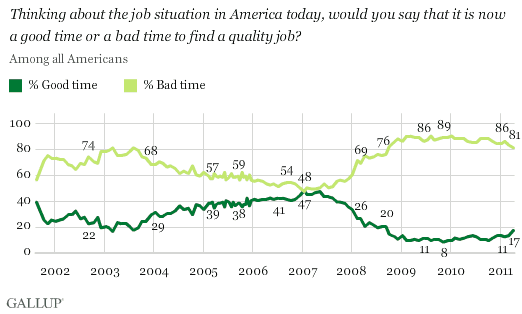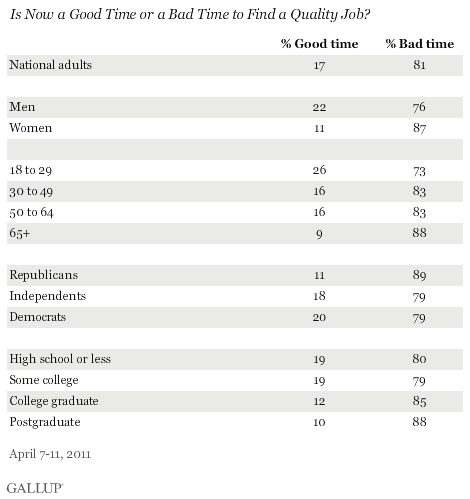PRINCETON, NJ -- Americans' views of the job market improved slightly in April to the most upbeat assessment since before the global economic collapse. While views are still negative, 17% of Americans say it is a good time to find a quality job, up from 13% in March, and the most since 20% said this in early September 2008.

Gallup has asked Americans monthly since 2001 whether it is a good time or a bad time to find a quality job. The current perceptions are the most positive since the 20% seen in a Sept. 8-11, 2008, Gallup poll. That September 2008 figure itself, however, was down markedly from views just a year and a half earlier. In January 2007, 48% of Americans said it was a good time to find a quality job -- the highest point since Gallup began tracking the measure in 2001.
Men, Younger Americans Most Positive
Views of the job market differ somewhat across demographic subgroups of the American population. Men are more positive than women; younger Americans are more positive than older Americans; Democrats and independents are more positive than Republicans; and those with lower levels of education are more positive than those with a college degree or postgraduate education.
The finding that young people are more optimistic about jobs reflects similar patterns found in previous years. Gallup unemployment data from last fall also indicate that young people and the less well-educated showed greater gains in employment than other groups.

Implications
A situation in which 17% of Americans say it is a good time to find a quality job is not optimal, even though it marks perceptions of the job market that are the most positive they have been in 2 1/2 years.
Gallup did not ask this question in the economic boom years of the late 1990s. However, the University of Connecticut and Rutgers University researchers who originated the question found in 1998, 1999, and 2000 that more than two-thirds of those in the workforce said it was a good time to find a quality job. This compares with 19% today among those Gallup classifies as in the workforce. This dramatic decline demonstrates just how bad Americans think the current jobs situation is.
This month's relatively positive attitudes about jobs parallel a slightly more positive trend in Gallup's non-seasonally adjusted unemployment rate for the first half of April.
Similarly, Gallup's Job Creation Index, based on workers' perceptions of hiring and firing at their own workplaces, remains higher so far in April than it has been -- including a three-day reading April 14-16 that is as high as Gallup has measured since September 2008.
Americans say unemployment is one of the two most important problems facing the country (the other being the economy in general). This "quality job" measure thus is an important indicator of the health of the U.S. economy, at least as the average American perceives it. Whether this month's improvement is the beginning of a sustained upward trend or is a short-term fluctuation is a key question going forward.
Survey Methods
Results for this Gallup poll are based on telephone interviews conducted April 7-11, 2011, with a random sample of 1,077 adults, aged 18 and older, living in the continental U.S., selected using random-digit-dial sampling.
For results based on the total sample of national adults, one can say with 95% confidence that the maximum margin of sampling error is ±4 percentage points.
Interviews are conducted with respondents on landline telephones and cellular phones, with interviews conducted in Spanish for respondents who are primarily Spanish-speaking. Each sample includes a minimum quota of 400 cell phone respondents and 600 landline respondents per 1,000 national adults, with additional minimum quotas among landline respondents for gender within region. Landline telephone numbers are chosen at random among listed telephone numbers. Cell phones numbers are selected using random digit dial methods. Landline respondents are chosen at random within each household on the basis of which member had the most recent birthday.
Samples are weighted by gender, age, race, Hispanic ethnicity, education, region, adults in the household, and phone status (cell phone-only/landline only/both, cell phone mostly, and having an unlisted landline number). Demographic weighting targets are based on the March 2010 Current Population Survey figures for the aged 18 and older non-institutionalized population living in U.S. telephone households. All reported margins of sampling error include the computed design effects for weighting and sample design.
In addition to sampling error, question wording and practical difficulties in conducting surveys can introduce error or bias into the findings of public opinion polls.View methodology, full question results, and trend data.
For more details on Gallup's polling methodology, visit www.gallup.com.
